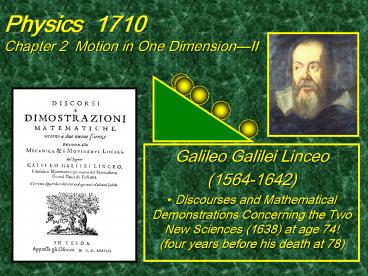Physics 1710 Chapter 2 Motion in One Dimension - PowerPoint PPT Presentation
Title:
Physics 1710 Chapter 2 Motion in One Dimension
Description:
Physics 1710. Chapter 2 Motion in One Dimension II. Galileo Galilei Linceo (1564-1642) ... Galileo Galilei Linceo. Galileo's rule of odd numbers: Under uniform ... – PowerPoint PPT presentation
Number of Views:42
Avg rating:3.0/5.0
Title: Physics 1710 Chapter 2 Motion in One Dimension
1
Physics 1710Chapter 2 Motion in One
DimensionII
- Galileo Galilei Linceo
- (1564-1642)
- Discourses and Mathematical Demonstrations
Concerning the Two New Sciences (1638) at age 74!
(four years before his death at 78)
2
Physics 1710Chapter 2 Motion in One Dimension
Galileos Ramp
3
Physics 1710Chapter 2 Motion in One
DimensionII
- 1' Lecture
- Under uniform acceleration ax
- Acceleration is constant (hence uniform) ax
constant (gt0,0, or lt0) - Velocity changes linearly in time vfinal
vinitial ax t - Displacement increases quadratically with
time xfinal xinitialvinitial t ½ ax t 2
4
Physics 1710Chapter 2 Motion in One
DimensionII
- Displacement is the change in position.
- ?x xfinal - xinitial
- ? is the change operator
- Change in x x at end x at start
- ?Balance Balancefinal - Balanceinitial
REVIEW
5
Physics 1710Chapter 2 Motion in One
DimensionII
- Velocity is the time rate of displacement.
- Average velocity vx, ave ? x / ?t
- Instantaneous velocity vx lim ?t?8 ?x /
?t dx/dt
REVIEW
6
Physics 1710Chapter 2 Motion in One
DimensionII
Position (m)
vaverage ?x/?t
Time (sec)
7
Physics 1710Chapter 2 Motion in One
DimensionII
- Velocity
Plot it!
vx dx/dt Instantaneous Velocity
Position (m)
vx, ave ?x / ?t AverageVelocity
Time (sec)
8
Physics 1710Chapter 2 Motion in One
DimensionII
- Acceleration is the time rate of change of
velocity. - Average acceleration ax, ave ?vx / ?t
- (vx,final -vx, initial )/ ?t
- Instantaneous acceleration ax lim ?t?8
?vx / ?t - dvx /dt
- ax dvx /dt d(dxx /dt)/dt d2x/dt 2
9
Physics 1710Chapter 2 Motion in One
DimensionII
- Motion Map
- From snap shots of motion at equal intervals of
time we can determine the displacement, the
average velocity and the average acceleration in
each case.
Uniform motion
Accelerated motion
10
Physics 1710Chapter 2 Motion in One Dimension
- Velocity
Plot them!
a2gt0
a1 0
Position (m)
Velocity (m/sec)
ax dvx /dt
Time (sec)
Time (sec)
11
Physics 1710Chapter 2 Motion in One
DimensionII
- Galileo Galilei Linceo
12
Physics 1710Chapter 2 Motion in One
DimensionII
- Galileos rule of odd numbers
- Under uniform acceleration from rest,
- a body will traverse distances in successive
equal intervals of time - that stand in ratio
- as the odd numbers 1,3,5,7,9
13
Physics 1710Chapter 2 Motion in One
DimensionII
- Galileos Ramp Demonstration
14
Physics 1710Chapter 2 Motion in One
DimensionII
Observation
- 0 0 0 2
- 01 1 1 2
- 13 4 2 2
- 45 9 3 2
- 97 16 4 2
- 169 25 5 2
- 2511 36 6 2
?x ? t 2 from rest (vinitial 0)
15
Physics 1710Chapter 2 Motion in One
DimensionII
- Kinematic Equations from Calculus
(dv/dt) a constant ?0t (dv/dt) dt ?0t a
dt ?vinitialvfinal dv a (t-0) ?v v vinitial
at The change in the instantaneous velocity is
equal to the (constant) acceleration multiplied
by its duration. v vinitial at
16
Physics 1710Chapter 2 Motion in One
DimensionII
- Kinematic Equations from Calculus
dx/dt v ?0t (dx/dt) dt ?0t v dt x
xinitial ?0t (vinitial at) dt
vinitial (t-0) ½ a(t 2-0) ?x vinitial t ½
at 2 The displacement under uniform acceleration
is equal to the displacement at constant velocity
plus one half the acceleration multiplied by the
square of its duration. x xinitial vinitial
t ½ at 2
17
Physics 1710Chapter 2 Motion in One
DimensionII
- Kinematic Equations from Calculus
v 2 (vinitial at) 2 v 2 vinitial 2 2
vinitial at a 2 t 2 v 2 vinitial 2 2a
(vinitial t ½ at 2) v 2 vinitial 2
2a?x The change in the square of the velocity
is equal to two times the acceleration multiplied
by the distance over which the acceleration is
applied.
18
Physics 1710Chapter 2 Motion in One
DimensionII
80/20 facts
Kinematic Equations (1-D Uniform a)
- vx final vx initial ax t
- x final x initial vx initial t ½ axt 2
- vx final 2 vx initial 2 2 ax (x final - x
initial )
19
Physics 1710Chapter 2 Motion in One
DimensionII
80/20 facts
- In free fall near the Earth, all bodies are
accelerated uniformly downward with an
acceleration of - az - g -9.80 m/s2.
20
Physics 1710Chapter 2 Motion in One
DimensionII
- Plot it!
Position (m)
Acceleration (m/s/s)
Velocity (m/sec)
0
0
dx/dt ?
dv/dt ?
-9.8 m/s/s
Time (sec)
Time (sec)
Time (sec)
21
Physics 1710Chapter 2 Motion in One
DimensionII
- The change in the instantaneous velocity is
equal to the (constant) acceleration multiplied
by its duration. ?v at - The displacement is equal to the displacement at
constant velocity plus one half of the product of
the acceleration and the square of its duration.
?x vinitial t ½ at 2 - The change in the square of the velocity is equal
to two times the acceleration multiplied by the
distance traveled during acceleration. ?v 2
2a ?x - The acceleration of falling bodies is 9.8 m/s/s
downward. a - g - 9.8 m/s/s
- Summary
22
Physics 1710Chapter 2 Motion in One
DimensionII
- 1' EssayOne of the following
- The main point of todays lecture.
- A realization I had today.
- A question I have.































